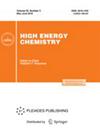胶体量子点: 4. 胶体量子点和基本光致发光定律
IF 0.6
4区 化学
Q4 CHEMISTRY, PHYSICAL
引用次数: 0
摘要
摘要 本文简要回顾了众所周知的光致发光定律和规则,并指出这些定律通常不适用于 CQD 溶液。研究表明,这是由于 CQDs 发光特性形成的特殊机制所致。本文介绍了新的通用光致发光定律的推导过程,该定律适用于任何类型的发光体,最近已在理论上得到证实,并以 CQDs 为例进行了实验验证。本文章由计算机程序翻译,如有差异,请以英文原文为准。

Colloidal Quantum Dots: 4. Colloidal Quantum Dots and Basic Photoluminescence Laws
Abstract
A brief review of the well-known laws and rules of photoluminescence is given, and it is shown that these laws usually do not hold for CQD solutions. It has been shown that this is due to a special mechanism for the formation of the luminescent properties of CQDs. The derivation of a new universal law of photoluminescence, applicable to any type of luminophores, which has recently been substantiated theoretically and verified experimentally using the example of CQDs, is presented.
求助全文
通过发布文献求助,成功后即可免费获取论文全文。
去求助
来源期刊

High Energy Chemistry
化学-物理化学
CiteScore
1.50
自引率
28.60%
发文量
62
审稿时长
6-12 weeks
期刊介绍:
High Energy Chemistry publishes original articles, reviews, and short communications on molecular and supramolecular photochemistry, photobiology, radiation chemistry, plasma chemistry, chemistry of nanosized systems, chemistry of new atoms, processes and materials for optical information systems and other areas of high energy chemistry. It publishes theoretical and experimental studies in all areas of high energy chemistry, such as the interaction of high-energy particles with matter, the nature and reactivity of short-lived species induced by the action of particle and electromagnetic radiation or hot atoms on substances in their gaseous and condensed states, and chemical processes initiated in organic and inorganic systems by high-energy radiation.
 求助内容:
求助内容: 应助结果提醒方式:
应助结果提醒方式:


